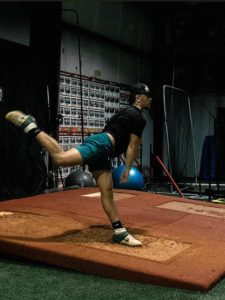 Do you want to take your pitching game to the next level and increase your velocity?
Do you want to take your pitching game to the next level and increase your velocity?
Sure, power is important when it comes to throwing those fastballs, but there's more to it than just brute strength.
Improving mobility in your ankles, hips and upper body can significantly impact the velocity behind your pitches. This can be achieved through exercises such as shoulder routines and hip stability training. In addition to mobility, proper mechanics play a huge role in increasing velocity. The kinetic chain refers to the coordination of muscles throughout the body for an effective pitch, starting from the feet all the way up to the release point of the ball.
Working with a pitching coach or attending a 3X Velocity Camp can help improve your mechanics and upgrade your kinetic chain. So don't just rely on mechanics alone - incorporate mobility, power, and strength and conditioning for a well-rounded approach to increasing your pitching velocity.
Pitching Velocity By Age
10 Years Old and Younger
- Fastball: 40 - 50 mph
- Changeup Velocity: 30 - 40 mph
- Knuckleball: 25 - 35 mph
11-12 Years Old
- Fastball: 50 - 60 mph
- Changeup Velocity: 40 - 50 mph
- Knuckleball: 30 - 40 mph
13-14 Years Old
- Fastball: 55 - 75 mph
- Changeup Velocity: 45 - 65 mph
- Knuckleball: 30 - 50 mph
High School
- Fastball: 75 - 85 mph
- Changeup Velocity: 65 - 75 mph
- Knuckleball: 50 - 60 mph
College and Professional
- Fastball: 80 - 95 mph
- Changeup Velocity: 70 - 85 mph
- Knuckleball: 55 - 70 mph
*Note: These numbers are only meant to be used as a rough estimate and may vary depending on the individual player. It is important to remember that velocity is not the only factor in determining a successful pitcher. Accuracy, control, and strategy all play significant roles in a pitcher's success as well. Additionally, these numbers may also differ based on the level of competition (i.e. professional players will generally have higher velocities than college players).
So if you're wondering when you can expect to see an increase in your pitching velocity, keep in mind that it will likely gradually increase throughout adolescence and into early adulthood. And remember, focus on overall technique rather than just trying to throw as hard as possible. This will not only help to prevent injuries but also improve your overall pitching performance.
Factors That Determine Pitching Velocity
Strength
Let's face it, we all want to throw harder. And while genetics may play a role in our ability to do so, there's one thing we can control: our strength. A simple way to increase throwing velocity and power? Start squatting, deadlifting, and benching. These exercises not only build overall strength but also target the muscles used in throwing (think glutes and shoulders). So what are you waiting for? Hit the weight room and watch those fastballs fly.
Power
Want to hit that ball out of the park or a 100mph fastball? It's all about power. And how do we develop this coveted athletic attribute? Olympic lifts, jumps, and cleans. These exercises train your body to apply force quickly and explosively, improving your power potential in any sport. So next time you're at the gym, grab those weights and get lifting! Your teammates (and opponents) will definitely take notice. If you want to learn how to do them correctly with a program to optimize your progression then get started with the 3X Pitching Velocity Training.
Mobility
Hip and ankle mobility can play just as big a role in maximizing your throwing velocity as strength development. And let's not forget about trunk mobility - a strong core can make all the difference in stabilizing your delivery. So don't neglect those hip mobility exercises and ankle stretches - they could be the missing piece to unlocking even more speed on your fastball. Keep developing that mobility, and watch those numbers rise on the radar gun. And hey, if you need some extra motivation to work on those often overlooked areas, just think about how envious all the other players will be when they see you effortlessly whipping off 95+mph.
Mass Equals Throwing Gas
Are you tired of being the scrawny one on the baseball field? Want to throw harder and faster like those bigger players? It's time to bulk up, baby.
First things first, nutrition is key. You can't just eat whatever you want and expect to gain weight. Focus on getting more calories and nutrients into your diet by incorporating protein-rich foods such as chicken, fish, eggs, beans, nuts, and tofu. Set a plan for how many meals you will have each day and what they will consist of. Check out the Top Velocity Nutrition Program if you want the best planning and guidance.




Velos by age…Knuckleballs are included? Mistake? Also, why are the curveballs omitted? Just curious. Thx.